A Circularly Polarized mmWave Dielectric-Resonator-Antenna Array for Off-Body Communications
Abstract
:1. Introduction
2. Design Methodology
2.1. A Single DRA Element
2.2. Single DRA Next to a Human Body
2.3. 2 × 2 DRA-Array Design
2.4. Array Next to a Human Body
2.5. Specific Absorption Rate (SAR) of the DRA Array
3. Measurements
4. Conclusions
Author Contributions
Funding
Institutional Review Board Statement
Informed Consent Statement
Data Availability Statement
Acknowledgments
Conflicts of Interest
References
- Petosa, A.; Ittipiboon, A.; Antar, Y.; Roscoe, D.; Cuhaci, M. Recent advances in dielectric-resonator antenna technology. IEEE Antennas Propag. Mag. 1998, 40, 35–48. [Google Scholar] [CrossRef]
- Yarga, S.; Sertel, K.; Volakis, J.L. Multilayer dielectric resonator antenna operating at degenerate band edge modes. IEEE Antennas Wirel. Propag. Lett. 2009, 8, 287–290. [Google Scholar] [CrossRef]
- Petosa, A.; Ittipiboon, A. Dielectric resonator antennas A historical review and the current state of the art. IEEE Antennas Propag. Mag. 2010, 52, 91–116. [Google Scholar] [CrossRef]
- Leung, K. Analysis of aperture-coupled hemispherical dielectric resonator antenna with a perpendicular feed. IEEE Trans. Antennas Propag. 2000, 48, 1005–1007. [Google Scholar] [CrossRef]
- Chu, H.; Guo, Y.-X. A novel approach for millimeter-wave dielectric resonator antenna array designs by using the substrate integrated technology. IEEE Trans. Antennas Propag. 2016, 65, 909–914. [Google Scholar]
- Petosa, A. Dielectric Resonator Antenna Handbook; Artech: Norwood, MA, USA, 2007. [Google Scholar]
- Hertleer, C.; Rogier, H.; Vallozzi, L.; Van Langenhove, L. A textile antenna for off-body communication integrated into protective clothing for firefighters. IEEE Trans. Antennas Propag. 2009, 57, 919–925. [Google Scholar] [CrossRef]
- Mashhadi, S.; Wu, Z.; Thamae, L. Investigation of a wearable broadband textile dielectric resonator antenna. In Proceedings of the 2010 Loughborough Antennas & Propagation Conference, Loughborough, UK, 8–9 November 2010; pp. 349–352. [Google Scholar]
- Al-Gburi, A.J.A.; Zakaria, Z.; Alsariera, H.; Akbar, M.F.; Ibrahim, I.M.; Ahmad, K.S.; Ahmad, S.; Al-Bawri, S.S. Broadband Circular Polarised Printed Antennas for Indoor Wireless Communication Systems: A Comprehensive Review. Micromachines 2022, 13, 1048. [Google Scholar]
- Qasaymeh, Y.; Almuhaisen, A.; Alghamdi, A.S. A Compact Sequentially Rotated Circularly Polarized Dielectric Resonator Antenna Array. Appl. Sci. 2021, 11, 8779. [Google Scholar]
- Kumar, S.; Lee, G.H.; Kim, D.H.; Choi, H.C.; Kim, K.W. Dual circularly polarized planar four-port MIMO antenna with wide axial-ratio bandwidth. Sensors 2020, 20, 5610. [Google Scholar] [CrossRef]
- Kulkarni, J.; Alharbi, A.G.; Elfergani, I.; Anguera, J.; Zebiri, C.; Rodriguez, J. Dual Polarized, Multiband Four-Port Decagon Shaped Flexible MIMO Antenna for Next Generation Wireless Applications. IEEE Access 2022, 10, 128132–128150. [Google Scholar] [CrossRef]
- Kulkarni, J.; Gangwar, R.K.; Anguera, J. Broadband and Compact Circularly Polarized MIMO Antenna With Concentric Rings and Oval Slots for 5G Application. IEEE Access 2022, 10, 29925–29936. [Google Scholar] [CrossRef]
- Abdou, T.S.; Khamas, S.K. A mm-wave Circularly Polarized Wristwatch Dielectric Resonator Antenna for Off-Body Communications. In Proceedings of the 2022 International Workshop on Antenna Technology (iWAT), Dublin, Ireland, 16–18 May 2022; pp. 168–171. [Google Scholar]
- Liu, Y.; Jiao, Y.C.; Weng, Z.; Zhang, C.; Chen, G. A novel millimeter-wave dual-band circularly polarized dielectric resonator antenna. Int. J. RF Microw. Comput. Aided Eng. 2019, 29, e21871. [Google Scholar]
- Abdulmajid, A.A.; Khamas, S.; Zhang, S.Y. Wide Bandwidth High Gain Circularly Polarized Millimetre-Wave Rectangular Dielectric Resonator Antenna. Prog. Electromagn. Res. M 2020, 89, 171–177. [Google Scholar] [CrossRef]
- Sun, Y.-X.; Leung, K.W. Circularly polarized substrate-integrated cylindrical dielectric resonator antenna array for 60 GHz applications. IEEE Antennas Wirel. Propag. Lett. 2018, 17, 1401–1405. [Google Scholar]
- Qureshi, A.A.; Klymyshyn, D.M.; Tayfeh, M.; Mazhar, W.; Börner, M.; Mohr, J. Template-based dielectric resonator antenna arrays for millimeter-wave applications. IEEE Trans. Antennas Propag. 2017, 65, 4576–4584. [Google Scholar]
- Mazhar, W.; Klymyshyn, D.M.; Wells, G.; Qureshi, A.A.; Jacobs, M.; Achenbach, S. Low-profile artificial grid dielectric resonator antenna arrays for mm-wave applications. IEEE Trans. Antennas Propag. 2019, 67, 4406–4417. [Google Scholar] [CrossRef]
- Kesavan, A.; Al-Hassan, M.a.; Ben Mabrouk, I.; Denidni, T.A. Wideband circular polarized dielectric resonator antenna array for millimeter-wave applications. Sensors 2021, 21, 3614. [Google Scholar] [CrossRef]
- Niayesh, M.; Kouki, A. LTCC-integrated dielectric resonant antenna array for 5G applications. Sensors 2021, 21, 3801. [Google Scholar]
- Liu, Y.-T.; Ma, B.; Huang, S.; Wang, S.; Hou, Z.J.; Wu, W. Wideband Low-Profile Connected Rectangular Ring Dielectric Resonator Antenna Array for Millimeter-Wave Applications. IEEE Trans. Antennas Propag. 2022, 71, 999–1004. [Google Scholar] [CrossRef]
- Mongia, R. Theoretical and experimental resonant frequencies of rectangular dielectric resonators. IEEE Proc. H Microwaves, Antennas Propag. 1992, 139, 98–104. [Google Scholar]
- Maknikar, R.D.; Kasabegoudar, V.G. Circularly polarized cross-slot-coupled stacked dielectric resonator antenna for wireless applications. Int. J. Wirel. Commun. Mob. Comput. 2013, 1, 68–73. [Google Scholar] [CrossRef]
- Ur-Rehman, M.; Malik, N.A.; Yang, X.; Abbasi, Q.H.; Zhang, Z.; Zhao, N. A low profile antenna for millimeter-wave body-centric applications. IEEE Trans. Antennas Propag. 2017, 65, 6329–6337. [Google Scholar]
- Hamed, T.; Maqsood, M. SAR calculation & temperature response of human body exposure to electromagnetic radiations at 28, 40 and 60 GHz mmWave frequencies. Prog. Electromagn. Res. M 2018, 73, 47–59. [Google Scholar]
- Althuway, P.R.M.R.B.K.M.A. Design and analysis of a compact circularly polarized DRA for off-body communications. AEU Int. J. Electron. Commun. 2021, 138, 153880. [Google Scholar]
- Vahora, A.; Pandya, K. Implementation of cylindrical dielectric resonator antenna array for Wi-Fi/wireless LAN/satellite applications. Prog. Electromagn. Res. M 2020, 90, 157–166. [Google Scholar]
- Lak, A.; Adelpour, Z.; Oraizi, H.; Parhizgar, N. Design and SAR assessment of three compact 5G antenna arrays. Sci. Rep. 2021, 11, 21265. [Google Scholar]
- Chahat, N.; Zhadobov, M.; Le Coq, L.; Alekseev, S.I.; Sauleau, R. Characterization of the interactions between a 60-GHz antenna and the human body in an off-body scenario. IEEE Trans. Antennas Propag. 2012, 60, 5958–5965. [Google Scholar]
- UKRI National Millimetre Wave Facility. Available online: https://www.sheffield.ac.uk/mm-wave/ (accessed on 6 October 2022).
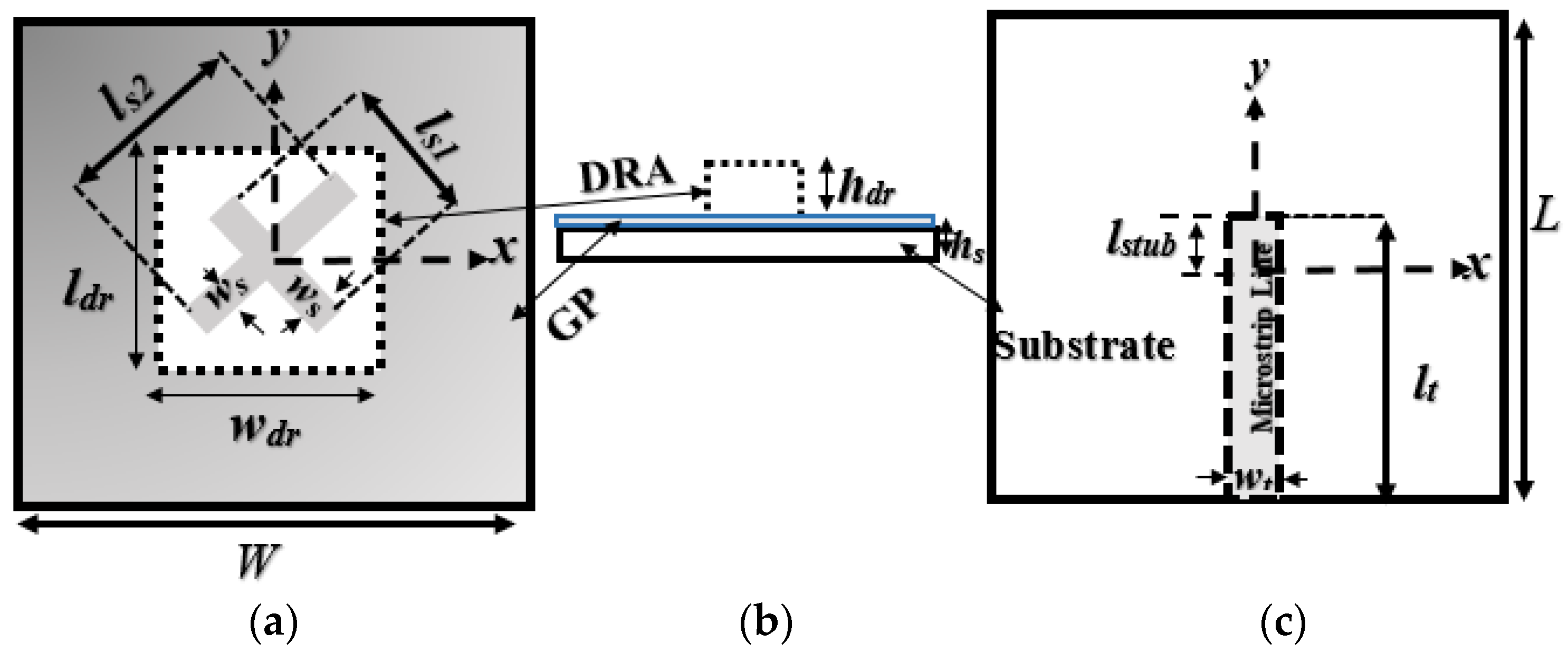


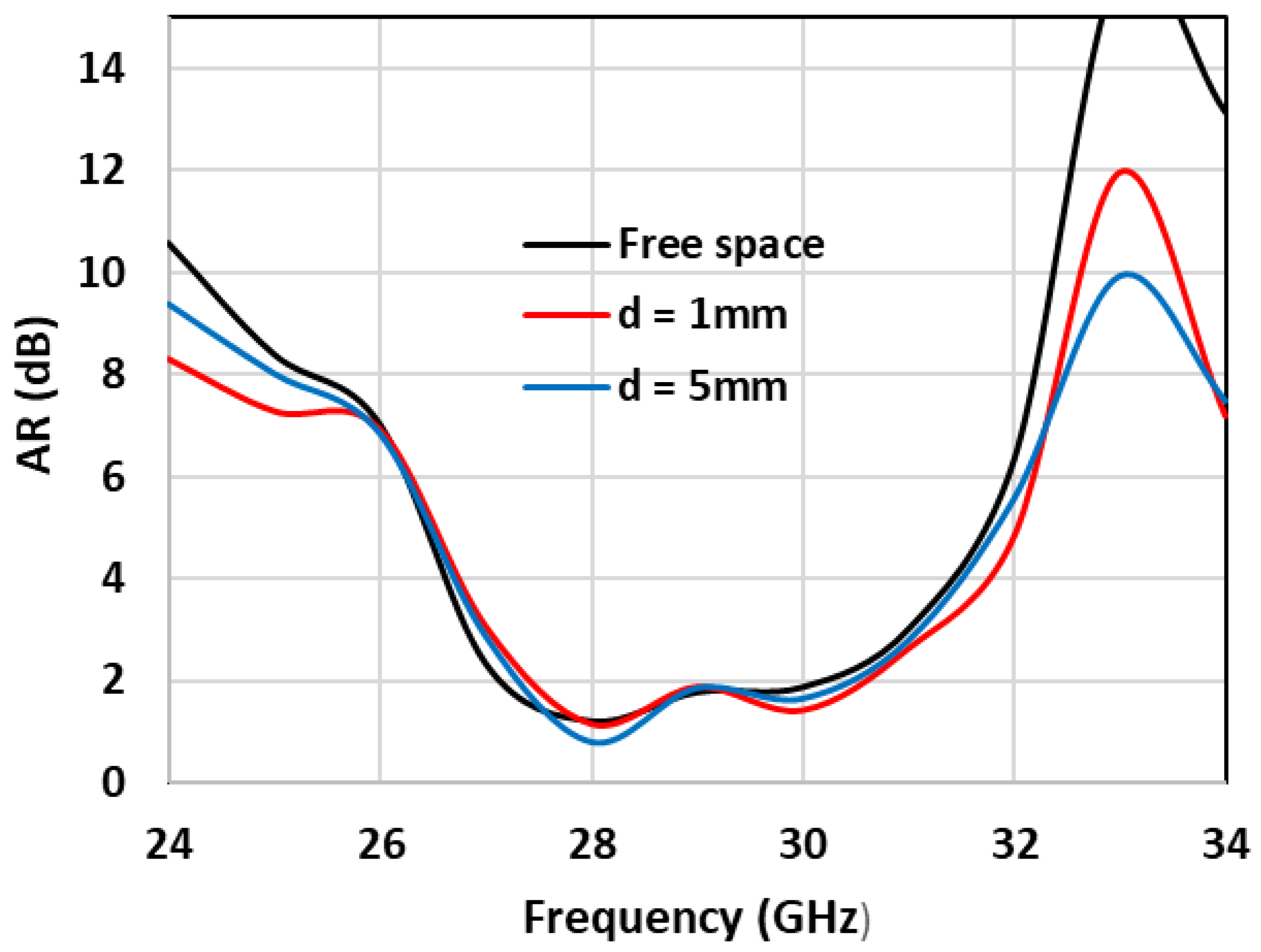

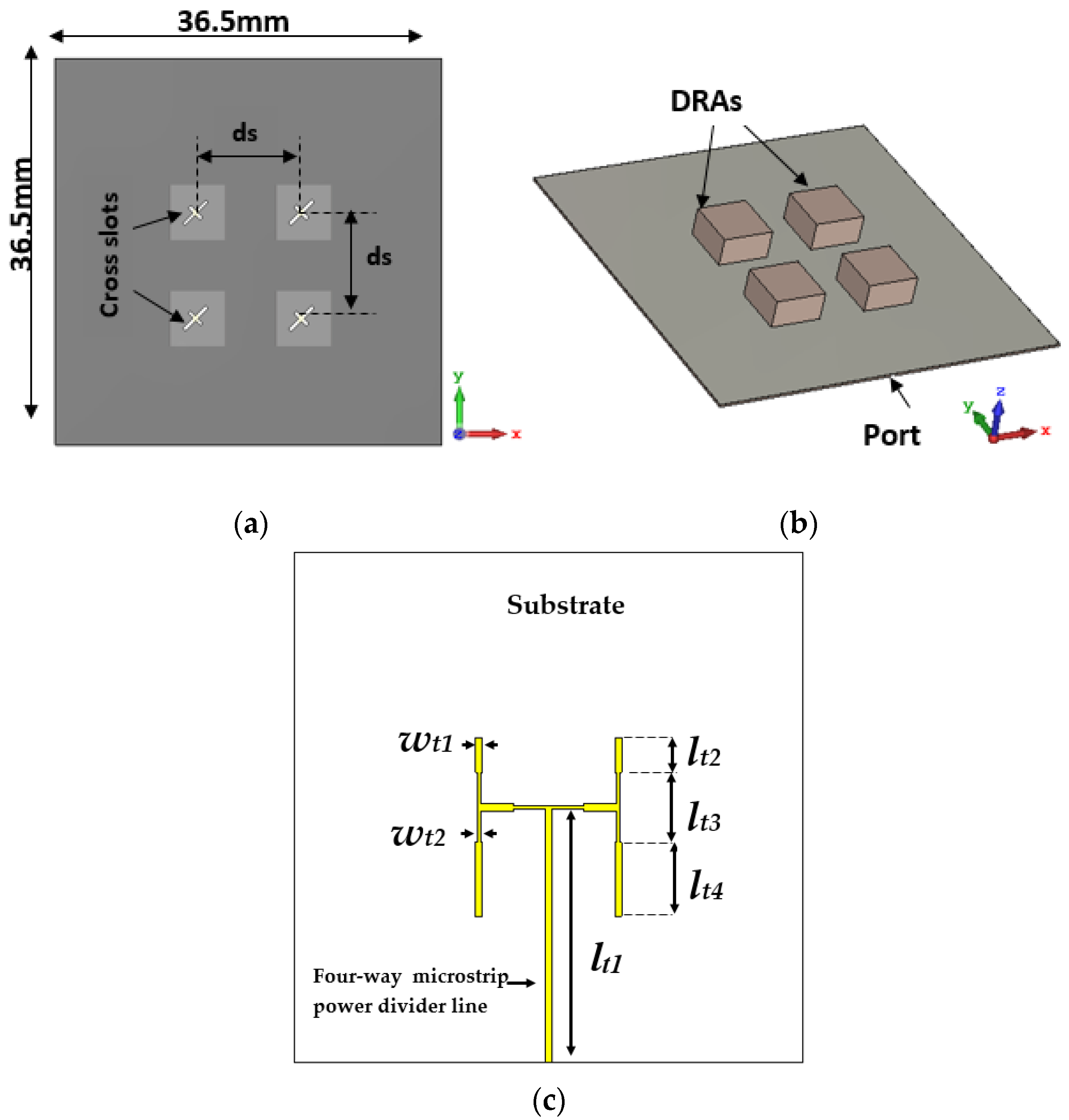
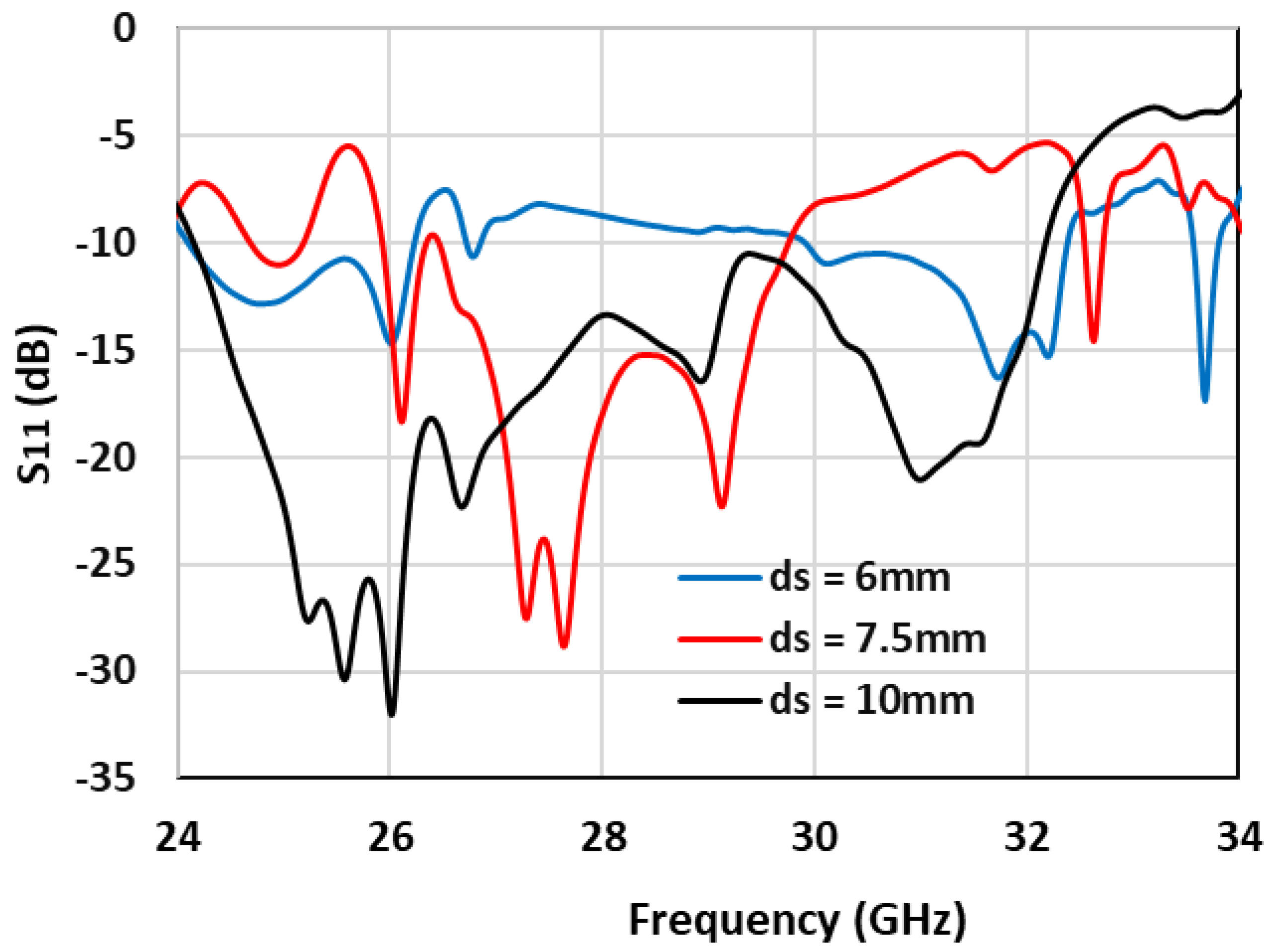

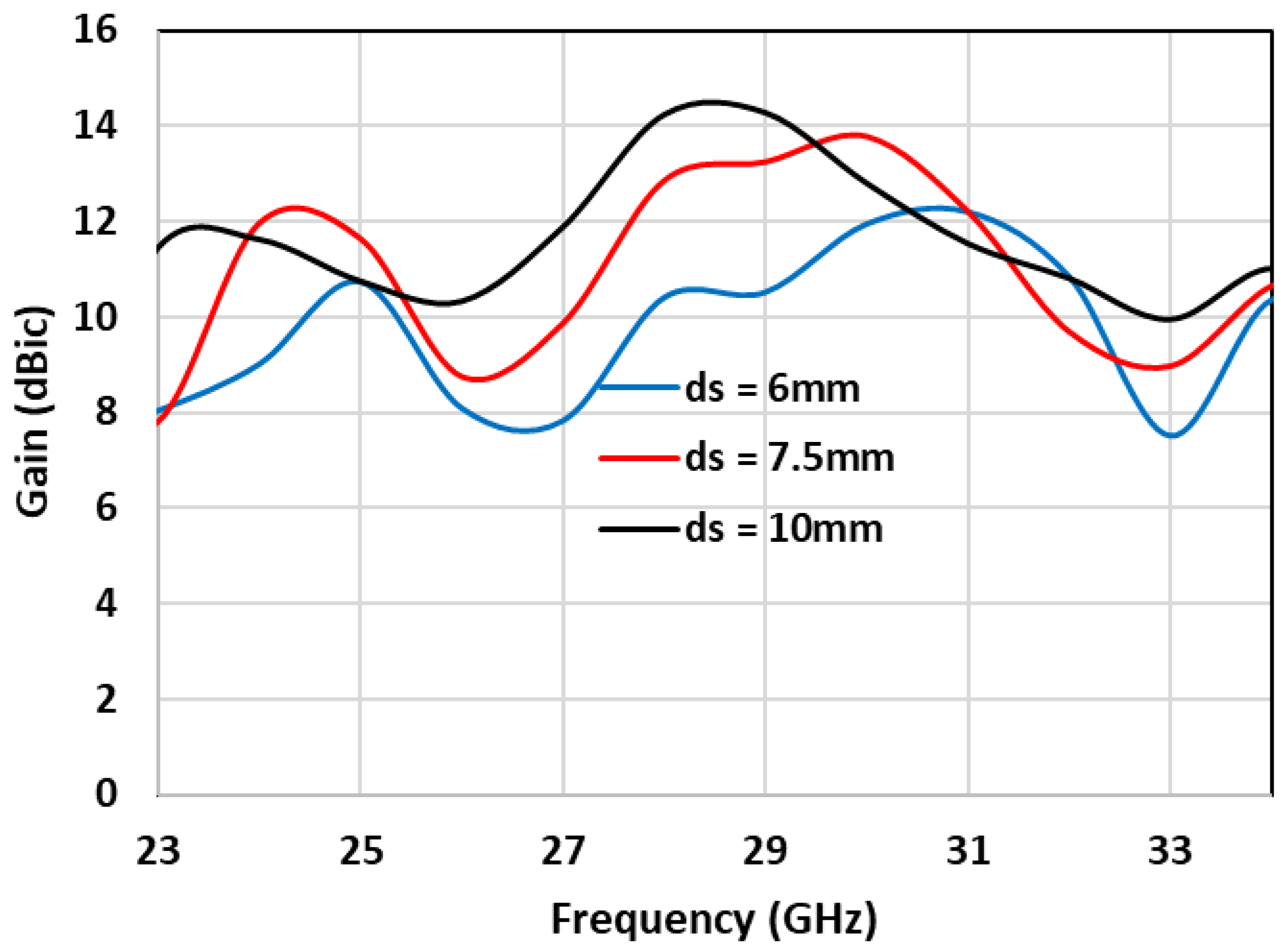

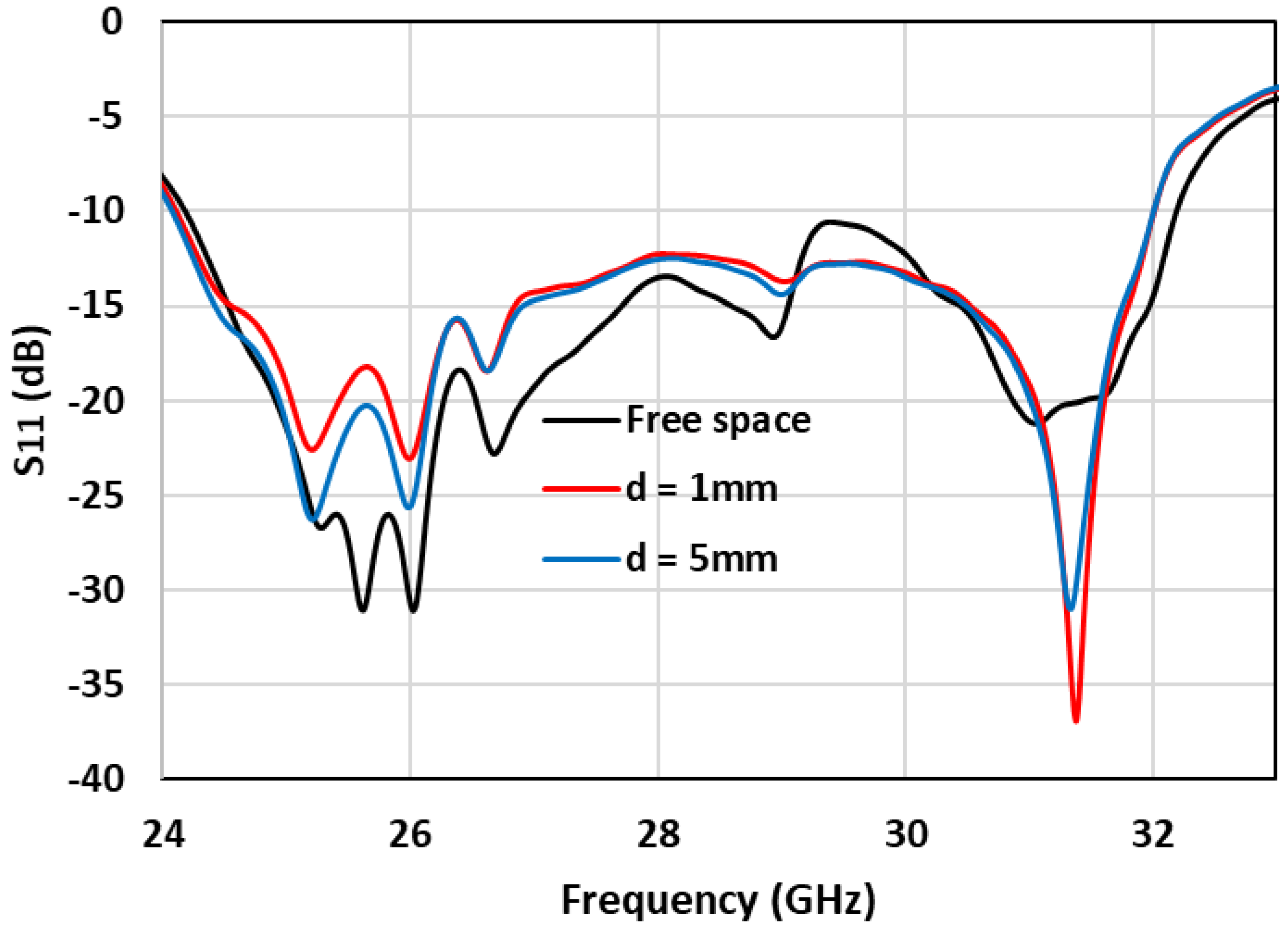
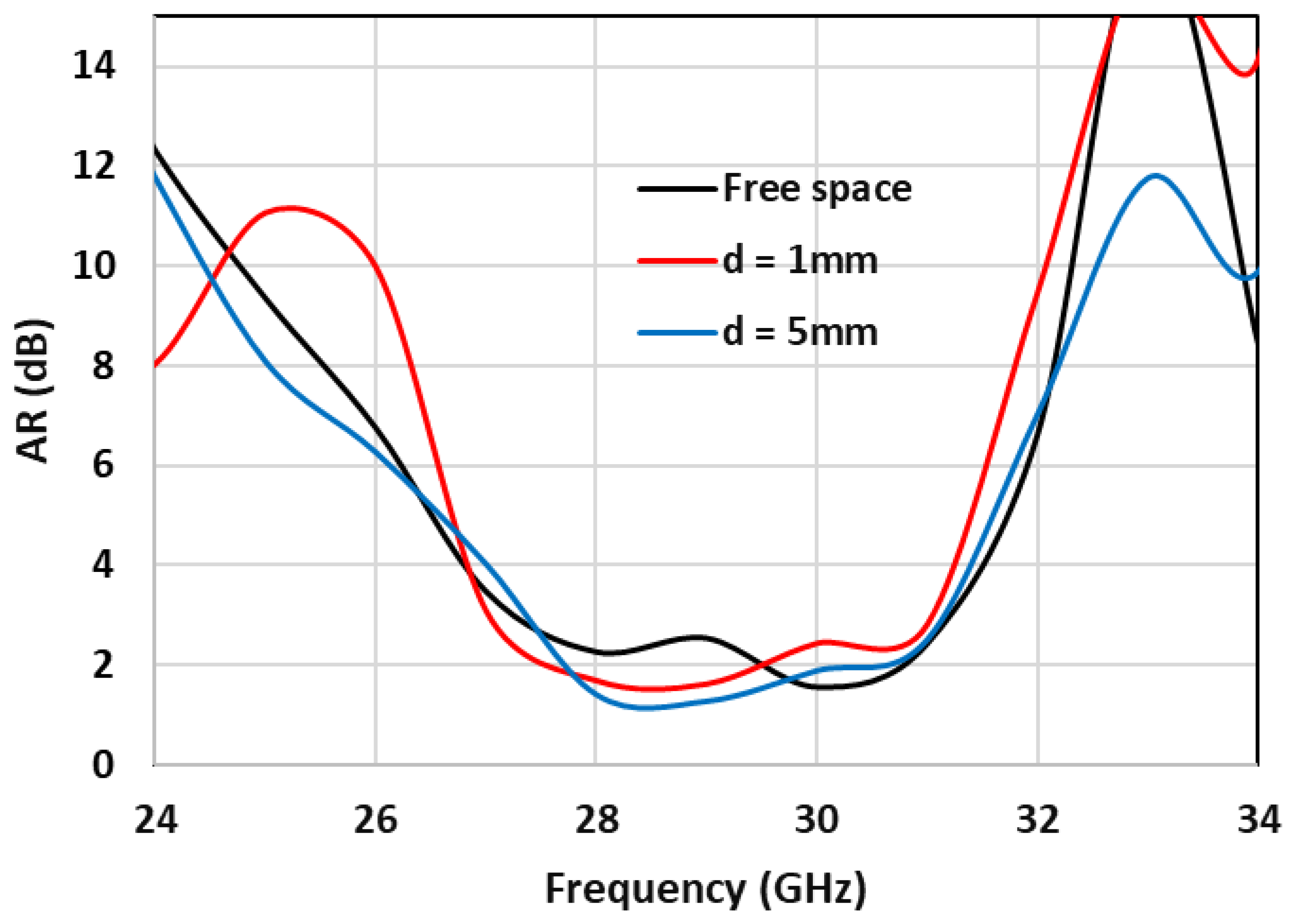
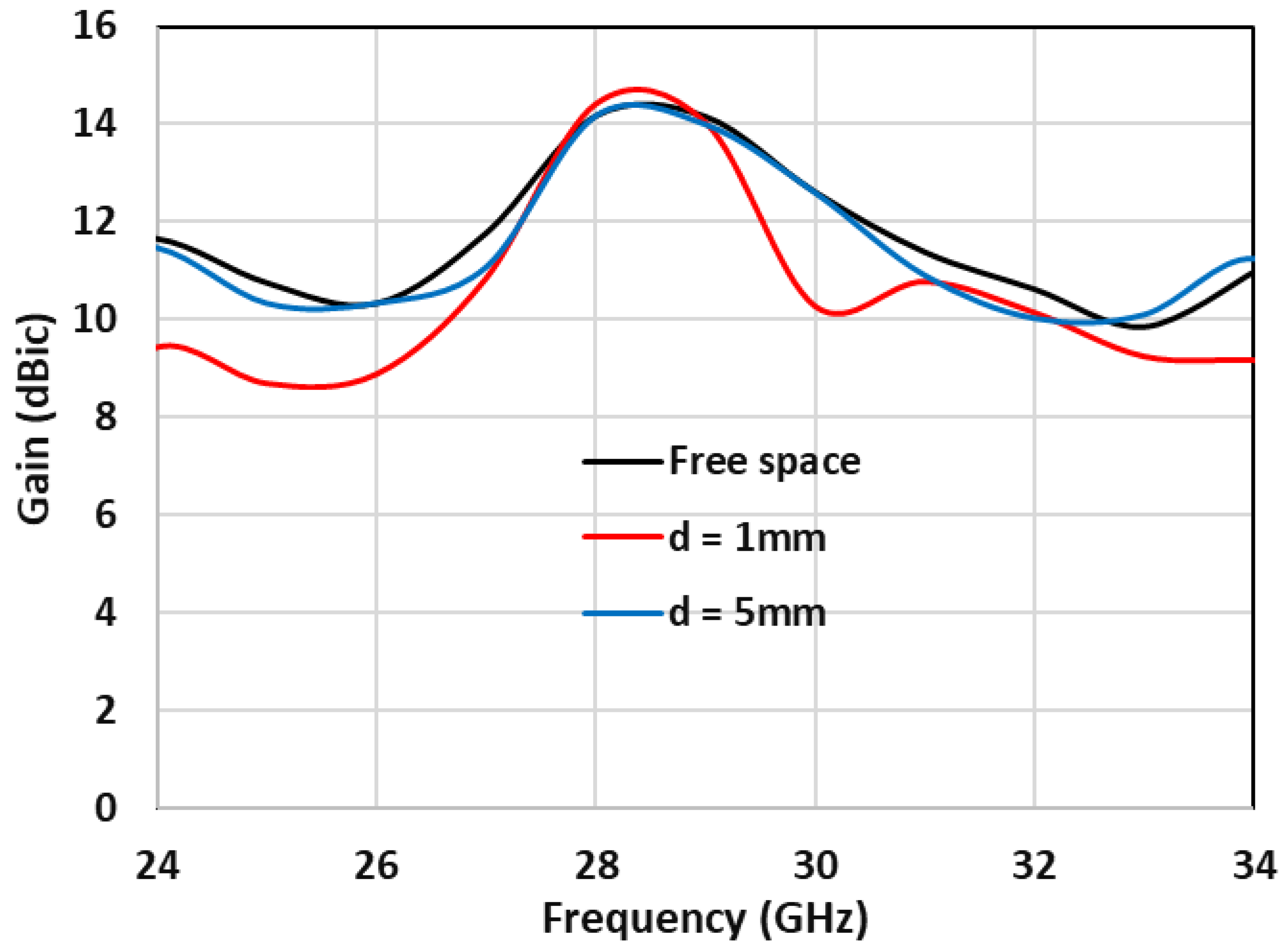
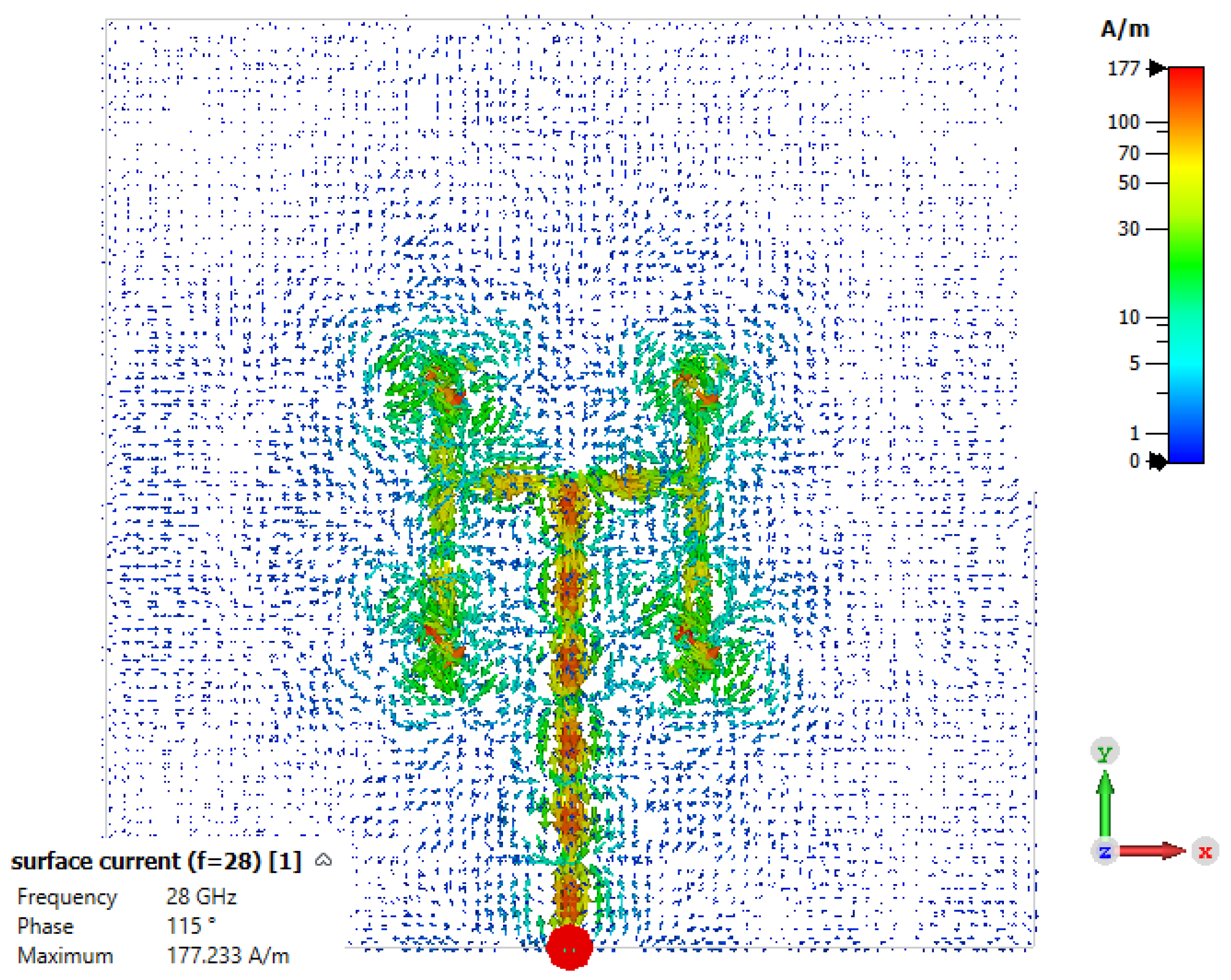



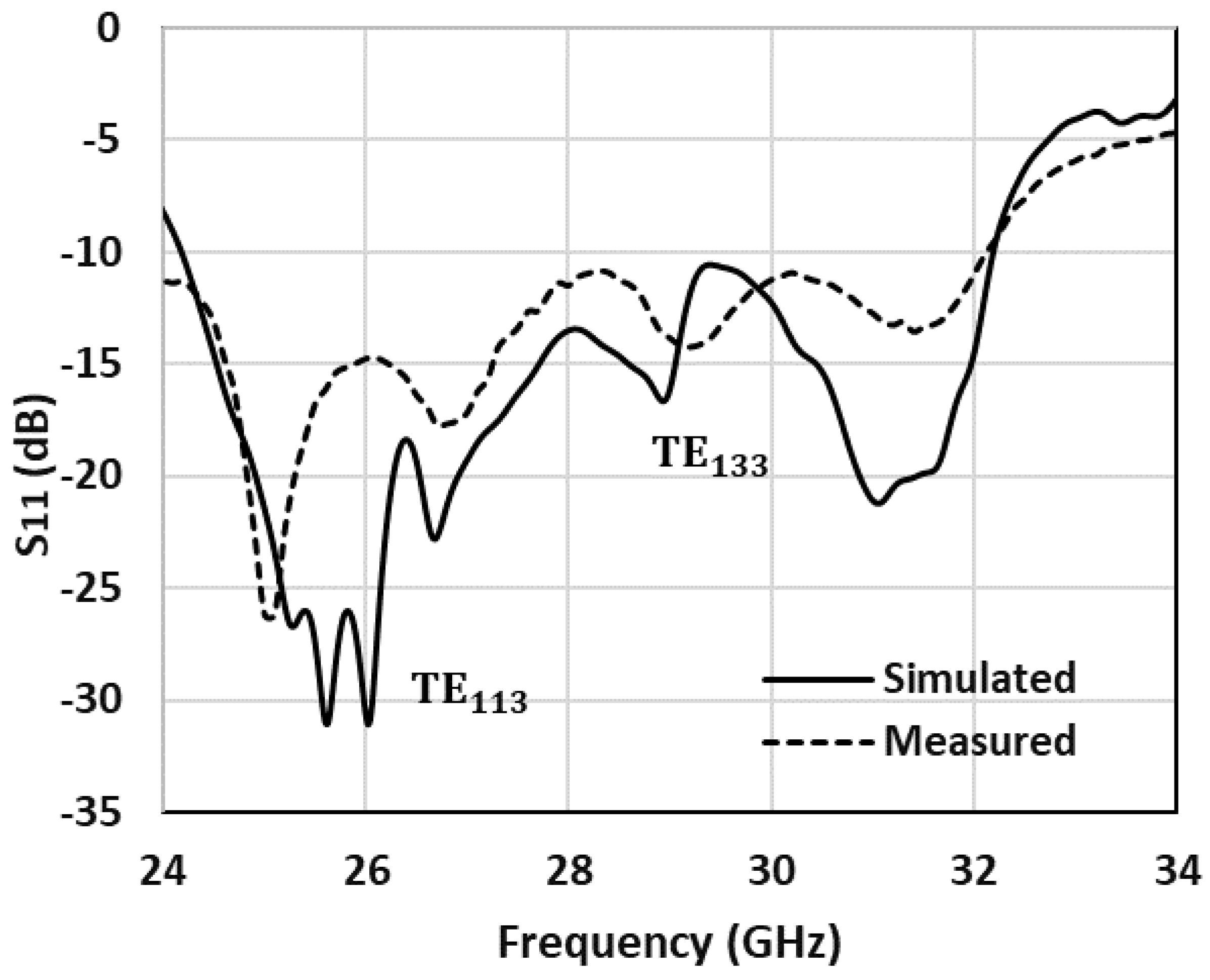
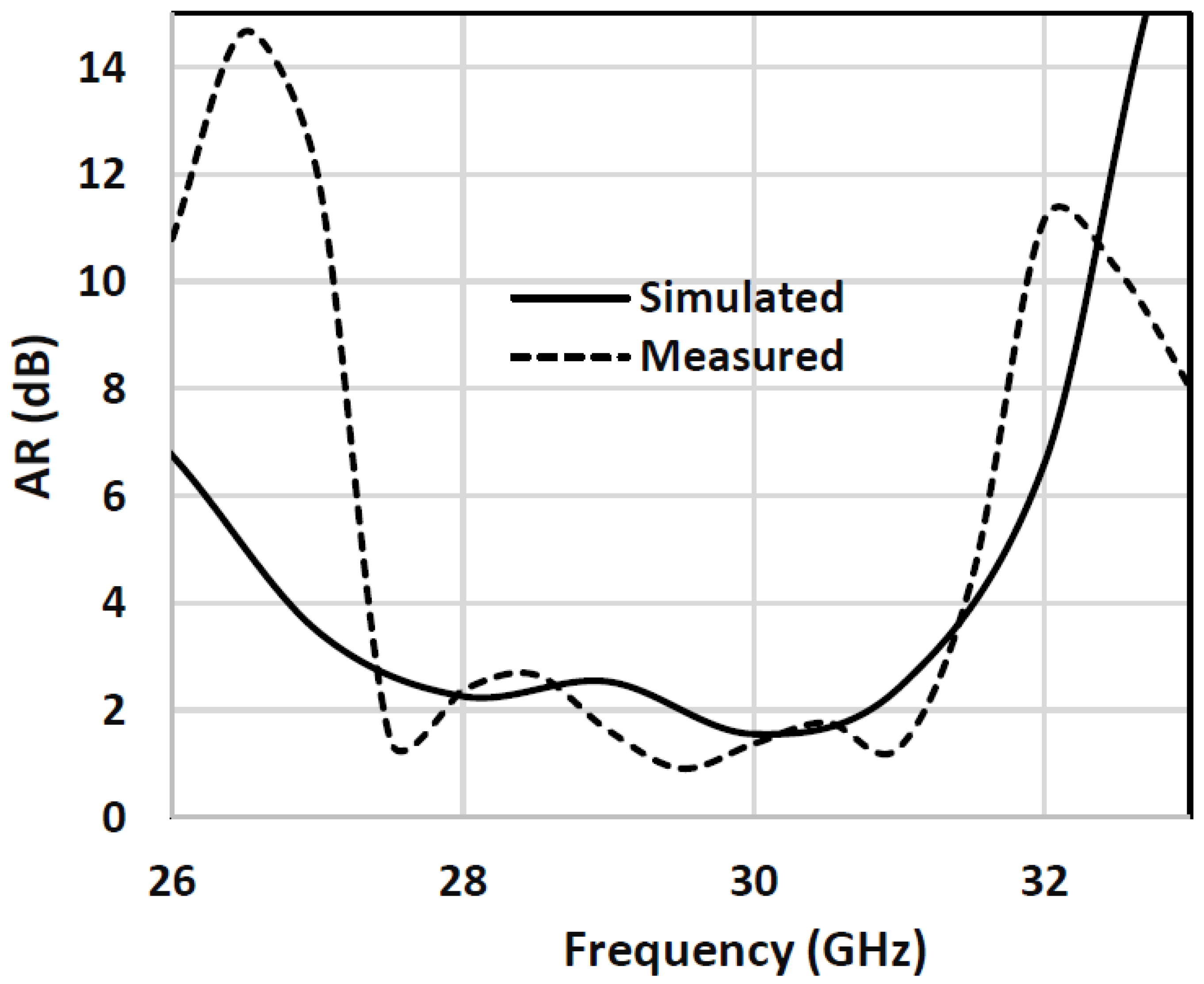
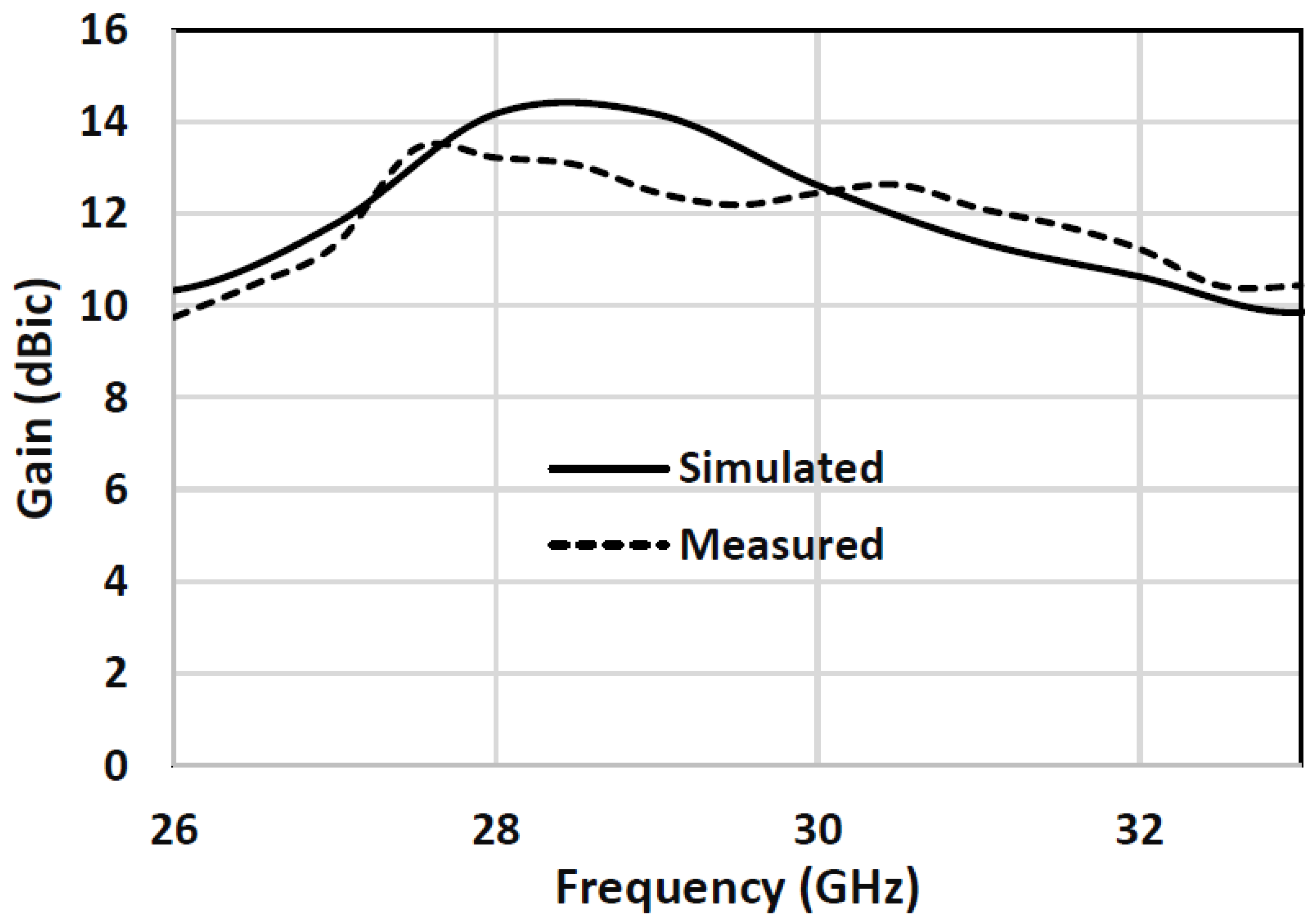
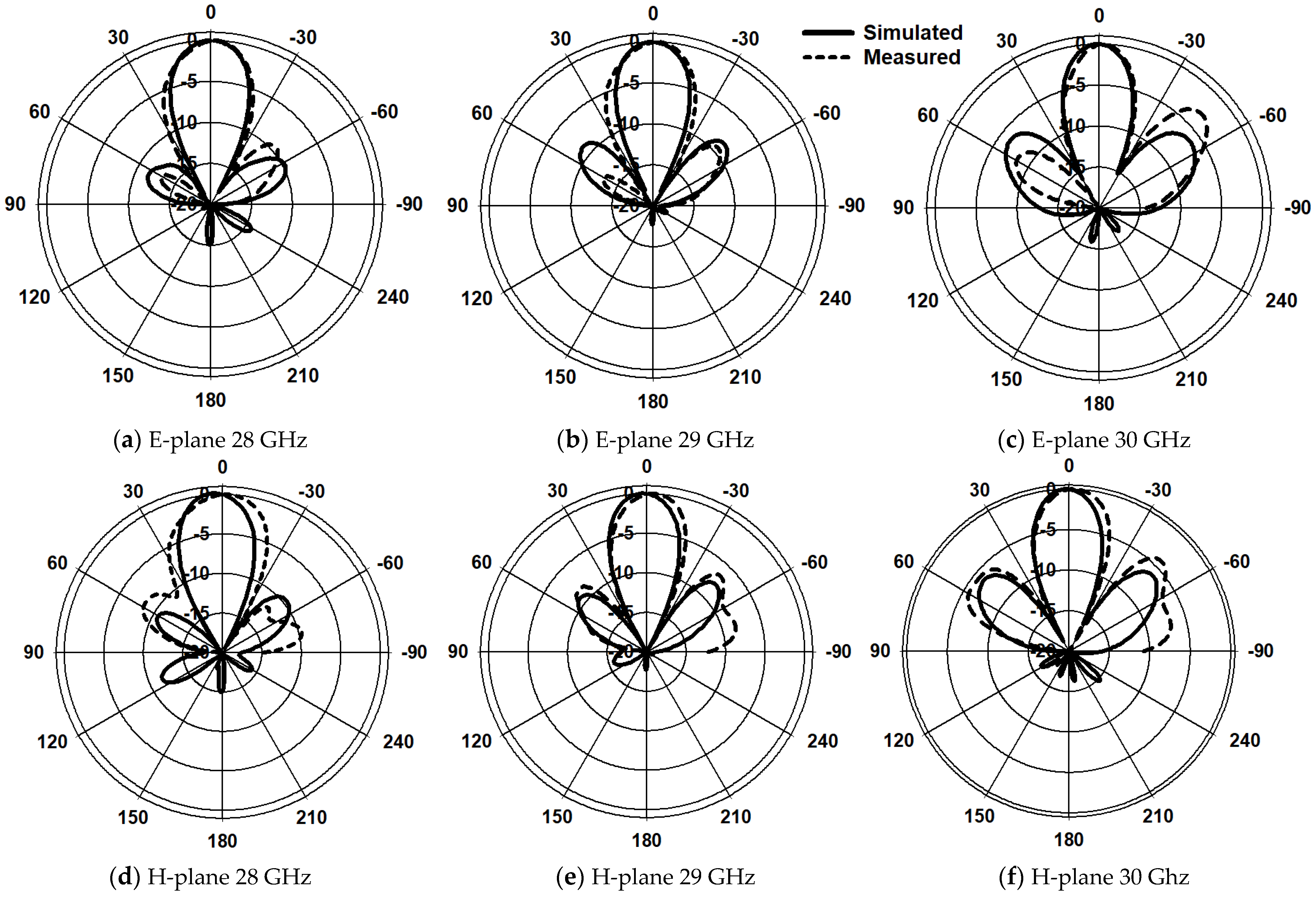
| Parameters | Value (mm) | Description |
|---|---|---|
| wdr | 5.2 | DRA width |
| ldr | 5.2 | DRA length |
| hdr | 2.9 | DRA height |
| L | 19 | Length of ground plane |
| W | 21 | Width of ground plane |
| hs | 0.254 | Substrate height |
| lt | 10.5 | Length of microstrip line |
| wt | 0.45 | Width of microstrip line |
| lstub | 1 | Stub length |
| ls1 | 1.7 | Length of the first slot |
| ls2 | 3.2 | Length of the second slot |
| ws | 0.35 | Width of the cross slot |
| Frequency (GHz) | Resonance Mode |
|---|---|
| 25 | |
| 27 | |
| 30 |
| Tissue | Skin | Fat | Muscle |
|---|---|---|---|
| Relative Permittivity | 16.55 | 6.09 | 25.43 |
| Density (kg/m3) | 1109 | 911 | 1090 |
| Conductivity (S/m) | 25.82 | 5.04 | 33.6 |
| Thickness (mm) | 1 | 2 | 10 |
| Standard | Input Power (dBm) | SAR(W/kg) | Distance (mm) |
|---|---|---|---|
| FCC/ANSI | 15 | 0.4495 | 5 |
| ICNIRP | 15 | 0.18123 | 5 |
| FCC/ANSI | 18 | 0.8975 | 5 |
| ICNIRP | 18 | 0.3619 | 5 |
| FCC/ANSI | 20 | 1.4225 | 5 |
| ICNIRP | 20 | 0.5735 | 5 |
| Ref. | Elements Number | fc (GHz) | Gain | S11 BW (%) | AR BW (%) | Size (mm3) |
|---|---|---|---|---|---|---|
| [5] | 4 | 30 | 12.7 dBic | 16.4 | 1.1 | - |
| [17] | 4 | 60 | 11.4 dBic | 26 | 15.9 | - |
| [18] | 4 | 60 | 10.5 dBi | 12 | LP | - |
| [19] | 8 | 32 | 12 dBi | 18.29 | LP | - |
| [20] | 4 | 30 | 9.5 dBic | 33.8 | 5 | 20 × 20 × 1.52 |
| [21] | 16 | 28.7 | 15.68 dBi | 9.81 | LP | 46 × 46 × 1.5 |
| [22] | 4 | 27.5 | 9.8 dBi | 31.6 | LP | 47 × 8 × 1.084 |
| This work | 4 | 28 | 13.7 dBic | 29 | 13 | 36.5 × 36.5 × 2.9 |
Disclaimer/Publisher’s Note: The statements, opinions and data contained in all publications are solely those of the individual author(s) and contributor(s) and not of MDPI and/or the editor(s). MDPI and/or the editor(s) disclaim responsibility for any injury to people or property resulting from any ideas, methods, instructions or products referred to in the content. |
© 2023 by the authors. Licensee MDPI, Basel, Switzerland. This article is an open access article distributed under the terms and conditions of the Creative Commons Attribution (CC BY) license (https://creativecommons.org/licenses/by/4.0/).
Share and Cite
Abdou, T.S.; Saad, R.; Khamas, S.K. A Circularly Polarized mmWave Dielectric-Resonator-Antenna Array for Off-Body Communications. Appl. Sci. 2023, 13, 2002. https://doi.org/10.3390/app13032002
Abdou TS, Saad R, Khamas SK. A Circularly Polarized mmWave Dielectric-Resonator-Antenna Array for Off-Body Communications. Applied Sciences. 2023; 13(3):2002. https://doi.org/10.3390/app13032002
Chicago/Turabian StyleAbdou, Tarek S., Rola Saad, and Salam K. Khamas. 2023. "A Circularly Polarized mmWave Dielectric-Resonator-Antenna Array for Off-Body Communications" Applied Sciences 13, no. 3: 2002. https://doi.org/10.3390/app13032002
APA StyleAbdou, T. S., Saad, R., & Khamas, S. K. (2023). A Circularly Polarized mmWave Dielectric-Resonator-Antenna Array for Off-Body Communications. Applied Sciences, 13(3), 2002. https://doi.org/10.3390/app13032002







